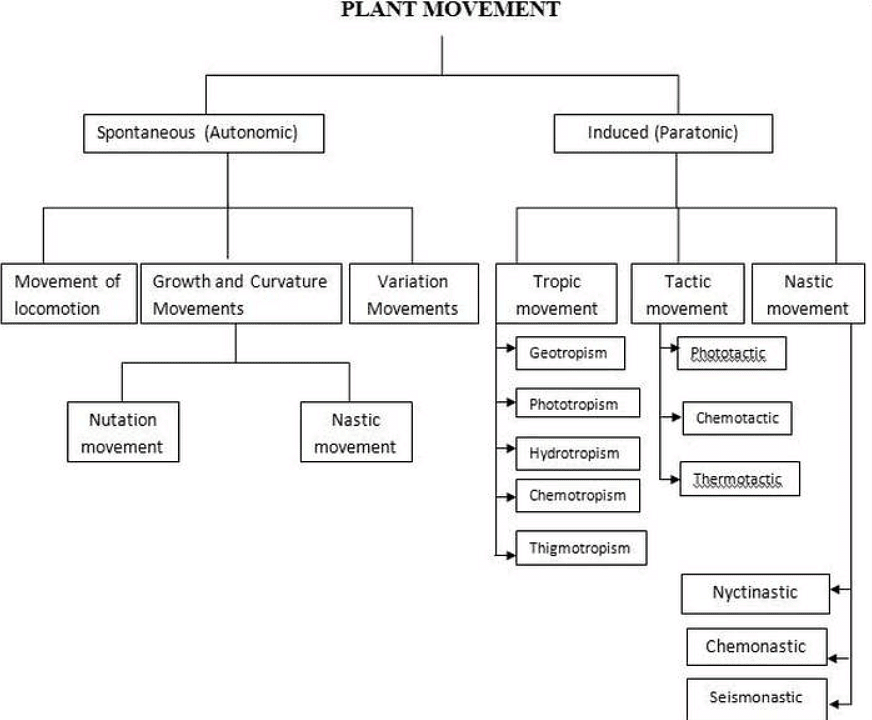Plant Movements | Botany Optional for UPSC PDF Download
Plant Movement: A Fascinating Phenomenon

Plant movement is a captivating aspect of the plant kingdom, involving various forms of bending, twisting, and elongation of plant parts or organs. These movements can be categorized into two types: spontaneous or autonomic movements, which occur without any external stimuli, and induced movements, which are triggered by specific stimuli. Let's take a closer look at each type and the different movements within them.
Autonomic or Spontaneous Movement
1. Movements of Locomotion
- These movements involve the entire plant body or specific organs, as well as the movement of materials within plant cells. They occur in response to inherent factors and are free and spontaneous.
- Examples of locomotion movements include cyclosis (streaming of protoplasm), oscillatory movements of Oscillatoria, and the motility of zoospores.
2. Growth and Curvature Movement
- Unequal growth on different sides of an organ leads to growth and curvature movements.
There are two types of these movements:- Nutation: This movement occurs when the side of the supporting organ in contact with the support grows at a slower rate than the opposite side. This results in a curvature that allows the supporting organ to spiral or twin around the support.
- Nastic: Nastic movements are caused by differences in the rate of growth on the two opposite surfaces of a plant organ. When the movement occurs due to faster growth on the upper surface of the organ, it is called epinastic movement. Conversely, when the movement occurs due to faster growth on the lower surface of the organ, it is known as hyponastic movement. Examples of nastic movements include the opening of floral buds and circinately coiled leaves.
3. Variation Movements

- These movements occur due to periodic variations in the turgidity of cells within an organ. One striking example is the Indian telegraph plant, Desmodium gyrans, where the two lateral leaflets move up and down in a rhythmic manner.
- The presence of large, thin-walled motor cells at the bases of the leaflets causes these periodic movements.
Paratonic or Induced Movements
1. Tropic Movements
Tropic movements are growth movements that occur in response to unidirectional external stimuli. They result in the positioning of plant parts in the direction of the stimulus.
There are several types of tropic movements, including:
- Phototropism: This curvature movement occurs when a plant is exposed to light from one direction. Stems generally show positive phototropism, curving toward the source of light, while roots display negative phototropism, growing away from the light source.
- Geotropism: Geotropism refers to growth movements induced by gravity. Primary roots exhibit positive geotropism, growing downward in the direction of gravity, while main shoots display negative geotropism, growing upward away from gravity. Secondary lateral roots and shoots show diageotropic responses, positioning themselves at an angle to the gravitational stimulus.
- Hydrotropism: Hydrotropism involves growth movements in response to water. Roots exhibit positive hydrotropism, bending toward the source of water.
- Chemotropism: Chemotropism is the movement caused by a unilateral stimulus of certain chemicals. For example, the movement of pollen tubes toward the ovary is a chemotropic response.
2. Tactic Movements
Tactic movements are induced movements of locomotion that occur in response to unidirectional external stimuli. The direction of these movements is determined by the direction of the stimulus.
The three main types of tactic movements are:
- Phototactic: These movements occur in response to unidirectional light. Algae, zoospores, and gametes exhibit positive phototactic movement when they swim toward diffused light and negative phototactic movement when they move away from strong light.
- Chemotactic: Chemotactic movements occur in response to certain chemical stimuli. Antherozoids of bryophytes and pteridophytes, for example, move towards the egg due to chemical signals.
- Thermotactic: Thermotactic movements occur in response to temperature stimuli. For instance, Vallisneria leaves exhibit rapid rotational cytoplasmic movement in response to increased temperature, and algae move from colder to warmer places.
3. Nastic Movements
Nastic movements can be triggered by changes in turgor or growth.
The three types of nastic movements are:
- Nyctinasty: Nyctinastic movements, also known as sleep movements, occur in response to day and light. The opening and closing of flowers in response to changes in light intensity are examples of nyctinasty. Some plants, like the legume Acacia totuosa, exhibit leaflet closure at night.
- Chemonasty: Chemonastic movements occur in response to chemical stimuli. The long peripheral tentacles of sundew leaves (Drosera), for instance, bend towards the middle of the leaf in response to organic nitrogenous compounds.
- Seismonasty: Seismonastic movements are triggered by touch stimuli or shocks. Mimosa pudica, also known as the sensitive plant, is a famous example of this movement. When its leaves are touched, the leaflets droop due to a loss of turgor, but they regain their upright position when the stimulus is removed.
In conclusion, plant movement is a diverse and fascinating phenomenon, showcasing the remarkable abilities of plants to respond and adapt to their environment. Whether it's the spontaneous movements of locomotion, the growth and curvature movements, or the induced tropic, tactic, and nastic movements, plants continue to amaze us with their ability to navigate and interact with their surroundings.
|
179 videos|143 docs
|















